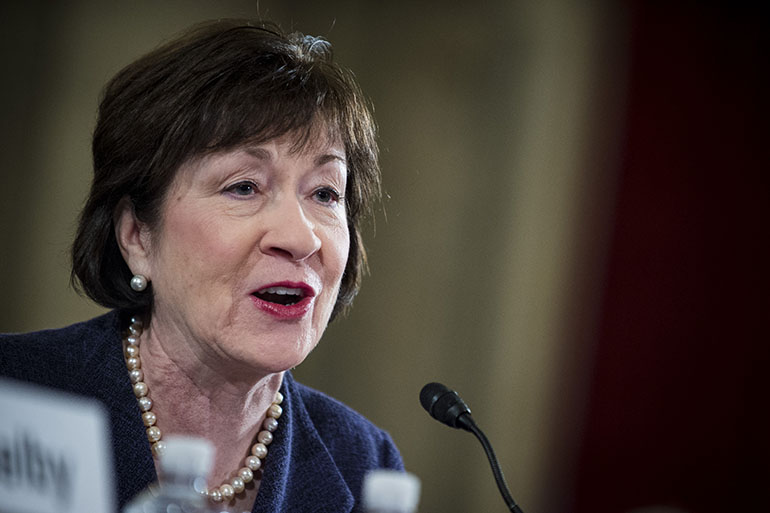As the GOP health care bill moves from the U.S. House of Representatives to the Senate, many consumers and lawmakers are especially worried that people with preexisting conditions won’t be able to find affordable health coverage.
There are a number of strategies under consideration, but one option touted by House Republicans borrows an idea that Maine used just before the Affordable Care Act went into effect. It’s called an “invisible high-risk pool” — invisible because people in it didn’t even know they were.
The Maine pool earned higher marks than most state high-risk pools because it had a key ingredient: enough money.
“The problem is that in order to do the Maine model — which I’ve heard many House people say that is what they’re aiming for — it would take $15 billion in the first year, and that is not in the House bill,” Sen. Susan Collins (R-Maine) told Politico. “There is actually $3 billion specifically designated for high-risk pools in the first year.”
Here’s how the Maine model worked: When a resident applied for health insurance, they had to fill out a questionnaire. If they had certain medical conditions known to be costly, their application was flagged for the high-risk pool. To consumers, it was seamless: They paid regular premiums and got the same sort of coverage as any other enrollee in their chosen health plan.
What was different was how their medical bills were paid. The state set up a nonprofit entity — the Maine Guaranteed Access Reinsurance Association, or MGARA. Mitchell Stein, an independent health policy consultant, explained that the money to pay for these high-cost patients came from two sources: the insurance policy premiums paid by patients within that high-risk pool and a $4-a-month surcharge on all policyholders in the state.
This “invisible high-risk pool” was just one part of a larger health reform law in Maine, Stein said, and that makes a straight-up assessment of how well the strategy worked difficult. But it’s “a great theory,” he said, “and can be an appropriate way to handle these things.”
Eric Cioppa, superintendent of Maine’s Bureau of Insurance, agrees with Stein. “In Maine, for the period of time it was operating, it worked very well,” Cioppa said.
It was active from 2012 through 2013, as 2014 marked the advent of the Affordable Care Act’s marketplace insurance exchanges. Though in effect only for a brief period, Cioppa said, the invisible high-risk pool did keep costs down in the individual market, where Anthem was the largest insurer.
Without the invisible high-risk pool, Cioppa said, Anthem would have increased rates more than 20 percent, based on estimates the insurer had to make. Instead, the rates went up less than 2 percent.
But Steve Butterfield, policy director of the Maine-based advocacy group Consumers for Affordable Health Care, cautioned that one crucial component that made Maine’s high-risk pool work was that it was well-funded. The strategy proposed in the House Republicans’ American Health Care Act is not, he said.
“An analysis that was done on what this program would need showed that it would need $15 billion to $20 billion per year to have any kind of reasonable impact on premiums,” Butterfield said.
The GOP bill does allocate about $15 billion to $20 billion — but that is supposed to last almost a full decade, not per year.
“One of our concerns,” Butterfield said, “is if the feds are going to put this in place and only kick in a token amount of money, is it going to be up to the states to pick up the slack and pay into this thing to make it work?”
Furthermore, Butterfield said, as the law stands now, under the Affordable Care Act, there’s no need for high-risk pools of any sort. The idea to use invisible high-risk pools is a solution to a problem that the GOP health care bill creates. Right now people can buy insurance regardless of their health status, whether or not they have a preexisting condition. It’s the GOP bill that would allow states to opt out of that Obamacare rule.
“I don’t understand,” Butterfield said, “why it would be a good idea to, on the one hand, say, ‘Well, we’re worried about preexisting conditions, so we’re going to throw not enough money at a problem we’re creating. At the same time, we’re going to allow insurance companies to charge sick people more.’ ”
And the invisible high-risk pool, said consultant Stein, is just one small proposal within the larger health bill.
“There’s nothing inherently wrong with it,” Stein said, “but it doesn’t really fix all the other problems of the bill.”
Which, he said, include cuts to Medicaid and potential changes to what are, under Obamacare, guaranteed “essential benefits.”
This story is part of a partnership that includes Maine Public, NPR and Kaiser Health News.








